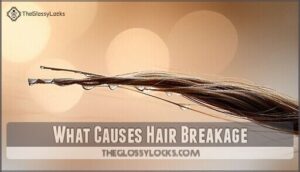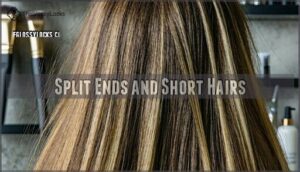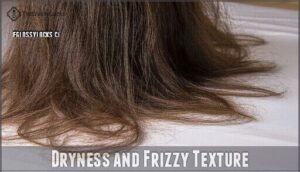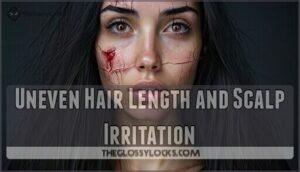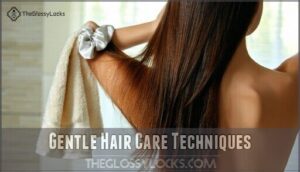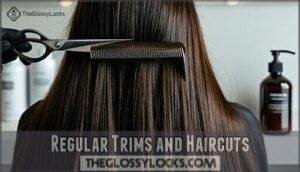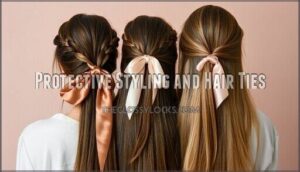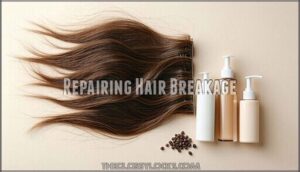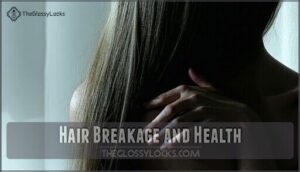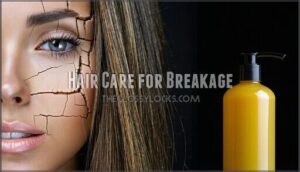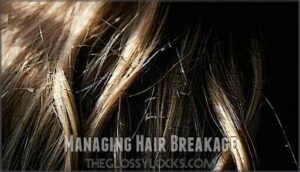This site is supported by our readers. We may earn a commission, at no cost to you, if you purchase through links.
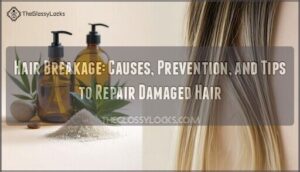 Hair breakage happens when your hair strands snap instead of stretching.
Hair breakage happens when your hair strands snap instead of stretching.
You’ll notice split ends, frizz, and shorter pieces throughout your hair. Common causes include heat styling, chemical treatments, tight hairstyles, and nutritional deficiencies.
Your hair is crying out for help, like a plant that’s been left without water too long.
To fix it, you’ll need to reduce heat styling, use moisturizing products, and trim damaged ends regularly.
Protein treatments can help strengthen weakened strands, but don’t overdo it—too much protein can make hair brittle.
The right balance of moisture and protein is just the beginning of your journey to stronger, healthier hair.
Table Of Contents
- Key Takeaways
- What Causes Hair Breakage
- Signs of Hair Breakage
- Hair Breakage Prevention
- Repairing Hair Breakage
- Hair Breakage and Health
- Hair Care for Breakage
- Managing Hair Breakage
- Frequently Asked Questions (FAQs)
- How do I stop breakage in hair?
- Why is my hair breaking out so much?
- Why is my hair breaking so much?
- What vitamin deficiency causes hair breakage?
- How do you recover from hair breakage?
- Can hair breakage indicate hormonal imbalances?
- How does water quality affect hair strength?
- Are there genetic factors in hair fragility?
- Can certain medications lead to hair breakage?
- Does scalp health directly impact hair breakage?
- Conclusion
Key Takeaways
- Focus on reducing heat styling, avoiding tight hairstyles, and using gentle tools to prevent breakage.
- Maintain a balance of moisture and protein by using deep conditioners and protein treatments sparingly.
- Proper nutrition, like eating protein, iron, and vitamins, strengthens strands and minimizes hair brittleness.
- Regular trims and protective styles prevent damage from worsening and keep hair healthier over time.
What Causes Hair Breakage
Hair breakage happens when the hair shaft weakens due to factors like chemical treatments, heat, and mechanical stress.
Poor nutrition and tight hairstyles can also strain your strands, making them more prone to snapping, which is a result of the hair breakage caused by these factors.
Nutritional Deficiencies and Hair
Hair breakage often stems from hair malnutrition caused by protein deficiency, vitamin deficiencies, or mineral imbalance.
A balanced diet fuels strong, healthy strands.
Include these essentials in your meals:
- Omega-3 Intake to hydrate and nourish hair.
- Iron and Zinc for follicle strength.
- Vitamin C and D to combat brittleness.
- Protein-rich foods to rebuild damaged hair fibers.
Chemical Treatments and Hair Weakness
Overusing perms, relaxers, or dyes weakens your strands, often leading to perm damage or relaxer breakage.
Chemicals strip away natural oils, leaving hair brittle and prone to snapping. Even keratin treatments, when overdone, can cause product buildup and hair protein loss.
| Issue | Cause | Effect |
|---|---|---|
| Dye Brittleness | Harsh coloring agents | Dry, fragile strands |
| Relaxer Breakage | Strong chemicals | Weak, damaged cuticles |
| Chlorine Effects | Pool exposure | Rough, brittle hair fibers |
Heat and Lack of Moisture
Using hot tools often? They strip natural oils, leaving strands brittle and prone to heat damage.
Without moisture, your hair’s like a dry sponge—vulnerable to breakage. Skipping hydration methods like conditioners or humectants worsens this, especially with sun exposure.
Protect your hair by using heat protectants before styling and opting for air drying when possible.
Regular oil treatments can replenish lost moisture, while consistent hair moisturizing keeps strands flexible. Balance heat use with care to prevent hair dryness and maintain strength.
Tight Hairstyles and Traction Alopecia
Constant tension from tight hairstyles can lead to traction alopecia, causing hair breakage and hairline recession.
Protect your hair and scalp with these tips:
- Reduce hairstyle frequency—opt for loose buns or braids.
- Prioritize early detection of scalp sensitivity or thinning to prevent permanent hair loss.
- Use hairstyle alternatives like silk scrunchies to minimize damage and maintain healthy strands.
Signs of Hair Breakage
Hair breakage often reveals itself through split ends, short broken hairs, or a frizzy texture that feels rough to the touch.
You might also notice uneven hair lengths, white spots on strands, or increased shedding during brushing or styling.
Split Ends and Short Hairs
Split ends and short hairs often signal hair breakage.
Split ends form when hair elasticity weakens, often due to heated tools or skipping trims.
Trimming frequency matters—regular cuts stop split ends from traveling upward, worsening hair damage.
Short hair styles caused by breakage appear uneven and scattered, especially near the hairline.
To disguise breakage, focus on protective styling and hydrating products.
Addressing hair breakage split ends early helps maintain healthier, stronger hair over time; conversely, healthy hair shows elasticity.
Dryness and Frizzy Texture
Dry, frizzy hair often signals a lack of moisture, leaving strands vulnerable to breakage.
Humidity effects and harsh product ingredients, like alcohol, strip natural oils, worsening the issue.
Understanding your hair’s porosity levels helps you choose effective hydration methods.
For overnight protection, try silk pillowcases or bonnets to lock in moisture, improving hair texture and reducing hair breakage caused by dryness.
Uneven Hair Length and Scalp Irritation
Uneven hair length often signals hair breakage, especially near the hairline.
A sensitive scalp and irritation causes further damage, highlighting deeper issues.
To tackle this:
- Assess growth patterns regularly to spot length discrepancies.
- Use gentle styling to minimize impact on fragile areas.
- Explore hair breakage treatments like soothing masks.
Prioritizing hair breakage prevention guarantees healthier strands and effective hair breakage solutions for both scalp and hair.
Hair Breakage Prevention
Preventing hair breakage starts with adopting gentle care techniques and avoiding habits that weaken strands.
By using protective styles, trimming regularly, and choosing the right tools, you can maintain stronger, healthier hair over time.
Gentle Hair Care Techniques
Protect your strands with these hair breakage tips:
- Swap tight elastics for silk scrunchies and silk pillowcases to reduce tension and friction.
- Use microfiber towels to gently pat hair dry, avoiding rough towel rubbing.
- Detangle wet hair with wide-toothed combs to prevent snapping.
- Air drying is your best friend—skip the heat tools when possible.
These simple changes can transform your hair care routine and support long-term hair breakage prevention. Consider purchasing silk scrunchies to further minimize hair damage.
Regular Trims and Haircuts
Every 8–10 weeks, a trim works wonders for hair breakage prevention.
By removing split ends, you’re protecting length retention and keeping your strands healthier.
Haircuts don’t hinder growth—they support it by stopping damage from creeping up the shaft.
Regular trims also improve hairstyle maintenance and shape preservation, making your hair more manageable.
Think of it as a reset button for your ends, ensuring you’re always a step ahead in your hair breakage tips routine.
Protective Styling and Hair Ties
In the context of preventing hair breakage, tension control is key.
Swap tight hairstyles for loose options to avoid hair breakage traction alopecia.
Use silk scarves or scrunchies as tie alternatives to reduce pressure.
Braid maintenance is essential—keep them neat but not overly tight.
For style longevity, avoid pulling on strands excessively.
If you use hair ties, opt for ones designed to minimize strain.
Many find that silk scarves protect hair while maintaining style.
These small changes offer effective hair breakage pressure relief while protecting your hair’s health.
Repairing Hair Breakage
Repairing hair breakage starts with nourishing your strands using targeted treatments like hair masks and protein formulas.
You’ll also need to protect your hair from further damage by adjusting your styling habits and using the right products to prevent breakage.
Hair Masks and Deep Conditioning
Deep conditioning and hair masks are game-changers for damaged hair repair.
Use DIY masks with natural Mask Ingredients like avocado or honey to hydrate and restore protein balance. Focus on Application Techniques, covering damaged ends and scalp.
For deeper repair, try overnight treatments or Leave-in Conditioners. Consider using a quality repair mask for superior results.
Regular Mask Frequency, like once a week, strengthens strands, reduces hair breakage, and enhances resilience. A consistent hair conditioning routine revitalizes your locks, leaving them healthier and shinier.
Protein Treatments and Hair Repair
Struggling with hair breakage? Protein treatments are your go-to for hair repair and strengthening.
They replenish lost protein, improving elasticity and sealing damaged cuticles.
Follow these steps:
- Pick a treatment—keratin, silk amino acids, or rice water.
- Apply to clean, damp hair.
- Let it sit for 5–7 minutes.
- Rinse thoroughly and follow with a deep conditioner.
- Use weekly for damaged hair or bi-weekly for maintenance.
Protein benefits include smoother, healthier strands and reduced breakage.
Avoiding Further Damage and Breakage
To prevent hair breakage, prioritize gentle detangling and use hydrating products.
Switch to silk pillowcases for night protection, reducing friction. Check product ingredients for harmful chemicals.
Embrace minimal manipulation by skipping tight hairstyles and aggressive brushing. Low-heat tools and consistent hair breakage treatments work best.
Hydration is key—dry strands break easily. Consistent salon visits can also help with long-term hair health.
Commit to a routine for effective hair damage prevention, focusing on hydration.
Hair Breakage and Health
Your overall health plays a direct role in maintaining strong, healthy hair, as issues like thyroid disorders, stress, and nutritional deficiencies can weaken strands and cause breakage.
Identifying and addressing these underlying factors is essential for supporting hair strength and reducing damage over time, which can be achieved by understanding the impact of thyroid disorders on hair health.
Thyroid Disorders and Hair Loss
When hormone imbalances like hypothyroidism or hyperthyroidism strike, hair often pays the price.
Thyroid disorders disrupt hormone levels, triggering diffuse hair loss and stubborn breakage.
The fix? Pair thyroid medication with gentle hair care and a balanced diet for regrowth and resilience.
- Hormone imbalance weakens hair.
- Thyroid medication promotes hair regrowth.
- Balanced nutrition restores hair strength.
- Early treatment prevents severe hair breakage, ensuring hair regrowth.
Eating Disorders and Hair Growth
Eating disorders like anorexia and bulimia disrupt growth cycles, causing hair thinning, breakage, and loss due to malnutrition effects.
Anagen breakage occurs as essential nutrients deplete, weakening strands. Bulimia’s impact may accelerate shedding, while anorexia can trigger soft lanugo hair.
Dietary correction and medical treatment restore nutrition, promoting regrowth. Hair health improves gradually, so patience and proper care are essential for recovery.
Stress and Hair Condition
When stress takes over, your hair feels it too.
Elevated stress hormones can throw your hair’s growth cycle off balance, causing Telogen Effluvium—a condition where strands shed prematurely.
Emotional stress often weakens hair, leading to breakage.
Managing stress is essential for both your mental health and hair health.
Try relaxation techniques like meditation or yoga to reduce hair stress.
With time, hair regrowth becomes possible, improving strength and reducing hair breakage stress.
Hair Care for Breakage
To prevent and manage hair breakage, you need to focus on the right tools and products that protect and strengthen your hair.
Choosing a gentle hairbrush, using pH-balanced shampoos, and applying moisturizing conditioners can substantially reduce damage and promote healthier strands.
Choosing The Right Hairbrush
Choosing the right hairbrush can make a world of difference for hair breakage prevention.
Match the brush to your hair texture and needs:
- Bristle types: Boar bristles for smoothness, nylon for thick hair.
- Brush shape: Round for volume, paddle for detangling long strands.
- Detangling wet hair: Use wide-tooth combs to minimize breakage.
Overbrushing damages strands, so stay gentle.
For oily hair, consider brushes that distribute natural oils to prevent buildup.
Prioritizing scalp health with rounded bristle tips keeps hair healthy and strong.
Shampoo Selection for Hair Health
Now that you know which brush works for your hair, let’s talk about shampoo – your first line of defense against breakage.
The right shampoo isn’t just about clean hair; it’s a foundation for hair strength. Look for products with a balanced pH of 4.5-5.5 to maintain your natural hair barrier.
Avoid harsh sulfates that strip away protective oils. Instead, choose gentle cleansers with ingredients like biotin or keratin that strengthen hair strands.
Consider your specific hair type – dry hair needs more moisture, while oily scalps benefit from clarifying formulas. Remember, washing too frequently can contribute to hair breakage.
Conditioner and Moisturizer Use
While proper shampoo sets the foundation, conditioners and moisturizers defend your hair against breakage.
Select conditioner types that match your needs—rinse-out for daily care or leave-in conditioners for extra protection.
Product application matters: apply from mid-lengths to ends, where moisture is needed most, and look for moisturizing ingredients like argan oil or shea butter.
Deep conditioning treatments once weekly restore hair moisture, making your strands stronger and less prone to breakage.
Managing Hair Breakage
You’ll need to take control of your hair breakage by understanding the facts and using proven methods that work for your specific hair type.
Managing breakage isn’t just about quick fixes but requires consistent care, from choosing the right products to recognizing when it’s time to consult a professional.
Debunking Hair Care Myths
Moving from proper product selection to understanding what’s truly effective, let’s clear up some persistent hair myths.
Many popular hair beliefs lead to wasteful or harmful practices.
Here are five common misconceptions:
- Cutting hair doesn’t speed up growth – hair grows from the follicle, not the ends
- Plucking one gray hair won’t create more – each follicle produces just one hair
- Daily washing isn’t automatically harmful – depends on your hair type
- Dry shampoo isn’t a complete substitute for regular washing
- Hair can’t fully "clean itself" without help
Hair Growth and Breakage Cycle
Your hair cycles through three distinct phases: anagen (growth), catagen (transition), and telogen (rest).
When this cycle gets disrupted by conditions like Telogen Arrest or Anagen Effluvium, breakage often follows.
Healthy follicles are your foundation—when they experience Follicle Dormancy, your strands become vulnerable to damage.
Understanding these Growth Stages helps you identify hair breakage causes and implement effective prevention strategies.
During Cycle Disruption, nutrients can’t reach your follicles properly.
Addressing hereditary hair loss may also be necessary for some individuals.
Think of your hair cycle as a garden—with regular care and patience, you’ll maintain stronger strands and minimize breakage!
Consulting a Hair Care Professional
When struggling with persistent hair breakage, consulting a healthcare professional can provide the targeted solutions you need.
A dermatologist or hair specialist will conduct a personalized hair analysis, identifying underlying causes that DIY methods might miss.
They’ll create a customized treatment plan with specific product recommendations based on your unique hair condition.
Unlike generic advice, professional hair breakage diagnosis addresses root issues—think of it as investing in expert care rather than temporary fixes.
Frequently Asked Questions (FAQs)
How do I stop breakage in hair?
Reduce heat styling, use protective products, and avoid tight hairstyles.
Choose gentle shampoos with neutral pH, deep condition regularly, and trim split ends.
Nutrition matters too—ensure adequate protein, zinc, and iron intake.
Why is my hair breaking out so much?
Is your hair sending out an SOS?
Your breakage could be caused by heat styling damage, chemical treatments, tight hairstyles, nutritional deficiencies, or stress.
Try reducing these factors to strengthen your strands.
Why is my hair breaking so much?
Your hair’s breaking because damage weakens strands.
Chemicals, tight hairstyles, brushing wet hair, and heat tools strip protection and cause breakage.
Focus on gentle care: use neutral pH shampoo, avoid heat, and moisturize regularly.
What vitamin deficiency causes hair breakage?
Imagine skipping spinach in your diet for weeks—your hair might show it.
Deficiencies in biotin, vitamin D, or iron weaken your strands, leading to breakage.
Eat wholesome foods to nourish and fortify your hair.
How do you recover from hair breakage?
To recover, trim split ends, nourish with deep conditioning treatments weekly, and use heat protectants during styling.
A balanced diet rich in proteins and vitamins strengthens hair over time.
Avoid tight hairstyles and over-brushing.
Can hair breakage indicate hormonal imbalances?
Hair breakage can scream hormonal imbalances louder than a siren.
Shifts in hormones, like during menopause or thyroid issues, weaken hair’s structure.
If breakage persists despite care, consider evaluating your hormones for a possible link to hair breakage.
How does water quality affect hair strength?
Your water’s quality plays a big role in keeping hair strong.
Hard water, filled with minerals like calcium and magnesium, weakens strands over time, while soft water helps retain moisture, leaving hair healthier and less prone to breakage, because hard water weakens hair.
Are there genetic factors in hair fragility?
Yes, genetics impact hair fragility.
Factors like hair thickness, density, and natural moisture levels depend on your genes.
Some inherited conditions weaken strands or cuticles, increasing breakage risks.
Proper care minimizes these genetically influenced vulnerabilities, particularly by addressing the role of genetics.
Can certain medications lead to hair breakage?
Breaking the camel’s back, certain medications like chemotherapy drugs, anticonvulsants, or beta-blockers can weaken hair structure.
They disrupt the hair growth cycle, causing brittle strands or thinning, so consult your doctor if hair breakage persists.
Does scalp health directly impact hair breakage?
A healthy scalp lays the foundation for strong hair.
Issues like dandruff or buildup can weaken hair follicles, increasing breakage.
Think of it as nurturing roots for a flourishing tree—scalp care matters more than you’d expect, which is why scalp care is important!
Conclusion
Think of hair breakage as a warning light for your hair’s health.
To restore strength and resilience, address the causes—be it heat, chemicals, or stress—and prioritize healthy habits like trimming damaged ends, using moisturizing and protein-rich treatments, and avoiding tight hairstyles.
Balance moisture and protein to rebuild your strands, and choose gentle tools and products to prevent further damage.
By focusing on prevention and repair, you can nurture stronger, healthier hair and reduce hair breakage effectively.

